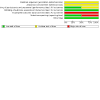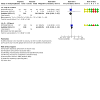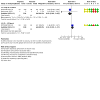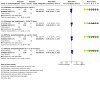Pharmacological interventions for acute attacks of vestibular migraine
- PMID: 37042545
- PMCID: PMC10097606
- DOI: 10.1002/14651858.CD015322.pub2
Pharmacological interventions for acute attacks of vestibular migraine
Abstract
Background: Vestibular migraine is a form of migraine where one of the main features is recurrent attacks of vertigo. These episodes are often associated with other features of migraine, including headache and sensitivity to light or sound. The unpredictable and severe attacks of vertigo can lead to a considerable reduction in quality of life. The condition is estimated to affect just under 1% of the population, although many people remain undiagnosed. A number of pharmacological interventions have been used, or proposed to be used, at the time of a vestibular migraine attack to help reduce the severity or resolve the symptoms. These are predominantly based on treatments that are in use for headache migraine, with the belief that the underlying pathophysiology of these conditions is similar. OBJECTIVES: To assess the benefits and harms of pharmacological interventions used to relieve acute attacks of vestibular migraine.
Search methods: The Cochrane ENT Information Specialist searched the Cochrane ENT Register; Central Register of Controlled Trials (CENTRAL); Ovid MEDLINE; Ovid Embase; Web of Science; ClinicalTrials.gov; ICTRP and additional sources for published and unpublished trials. The date of the search was 23 September 2022.
Selection criteria: We included randomised controlled trials (RCTs) and quasi-RCTs in adults with definite or probable vestibular migraine comparing triptans, ergot alkaloids, dopamine antagonists, antihistamines, 5-HT3 receptor antagonists, gepants (CGRP receptor antagonists), magnesium, paracetamol or non-steroidal anti-inflammatory drugs (NSAIDs) with either placebo or no treatment. DATA COLLECTION AND ANALYSIS: We used standard Cochrane methods. Our primary outcomes were: 1) improvement in vertigo (assessed as a dichotomous outcome - improved or not improved), 2) change in vertigo (assessed as a continuous outcome, with a score on a numerical scale) and 3) serious adverse events. Our secondary outcomes were: 4) disease-specific health-related quality of life, 5) improvement in headache, 6) improvement in other migrainous symptoms and 7) other adverse effects. We considered outcomes reported at three time points: < 2 hours, 2 to 12 hours, > 12 to 72 hours. We used GRADE to assess the certainty of evidence for each outcome. MAIN RESULTS: We included two RCTs with a total of 133 participants, both of which compared the use of triptans to placebo for an acute attack of vestibular migraine. One study was a parallel-group RCT (of 114 participants, 75% female). This compared the use of 10 mg rizatriptan to placebo. The second study was a smaller, cross-over RCT (of 19 participants, 70% female). This compared the use of 2.5 mg zolmitriptan to placebo. Triptans may result in little or no difference in the proportion of people whose vertigo improves at up to two hours after taking the medication. However, the evidence was very uncertain (risk ratio 0.84, 95% confidence interval 0.66 to 1.07; 2 studies; based on 262 attacks of vestibular migraine treated in 124 participants; very low-certainty evidence). We did not identify any evidence on the change in vertigo using a continuous scale. Only one of the studies assessed serious adverse events. No events were noted in either group, but as the sample size was small we cannot be sure if there are risks associated with taking triptans for this condition (0/75 receiving triptans, 0/39 receiving placebo; 1 study; 114 participants; very low-certainty evidence). AUTHORS' CONCLUSIONS: The evidence for interventions used to treat acute attacks of vestibular migraine is very sparse. We identified only two studies, both of which assessed the use of triptans. We rated all the evidence as very low-certainty, meaning that we have little confidence in the effect estimates and cannot be sure if triptans have any effect on the symptoms of vestibular migraine. Although we identified sparse information on potential harms of treatment in this review, the use of triptans for other conditions (such as headache migraine) is known to be associated with some adverse effects. We did not identify any placebo-controlled randomised trials for other interventions that may be used for this condition. Further research is needed to identify whether any interventions help to improve the symptoms of vestibular migraine attacks and to determine if there are side effects associated with their use.
Trial registration: ClinicalTrials.gov NCT00360282.
Copyright © 2023 The Authors. Cochrane Database of Systematic Reviews published by John Wiley & Sons, Ltd. on behalf of The Cochrane Collaboration.
Conflict of interest statement
Katie Webster: none known.
Afrose Dor: none known.
Luma Haj Kassem: none known.
Kevin Galbraith: none known.
Natasha A Harrington‐Benton: Natasha Harrington‐Benton is the Director of the Ménière's Society, a national charity supporting people with vestibular conditions. The Ménière’s Society supports research in various ways, including distributing surveys and/or providing grant funding for projects studying vestibular conditions. Some of the studies they have previously funded may be included in the review. They do not carry out the research themselves and are not directly involved in projects.
Owen Judd: none known.
Diego Kaski: none known.
Otto R Maarsingh: none known.
Samuel MacKeith: Samuel MacKeith is the Assistant Co‐ordinating Editor of Cochrane ENT, but had no role in the editorial process for this review. He sees patients with vestibular migraine disease in his NHS and private practice and is the co‐director of a company providing private vestibular function testing services.
Jaydip Ray: none known.
Vincent A Van Vugt: none known.
Martin J Burton: Martin Burton undertook private practice until March 2020 and saw some patients with balance disorders, including vestibular migraine. He is the Co‐ordinating Editor of Cochrane ENT, but had no role in the editorial process for this review.
Figures








Update of
- doi: 10.1002/14651858.CD015322
References
References to studies included in this review
NCT02447991 {published data only}
-
- NCT02447991. Rizatriptan for episodic dizziness in vestibular migraine [A phase II/III trial on rizatriptan for vestibular migraine]. http://clinicaltrials.gov/show/NCT02447991 (first received 19 May 2015). [CLINICALTRIALS.GOV: NCT02447991]
Neuhauser 2003 {published data only}
-
- Neuhauser H, Radtke A, Brevern M, Lempert T. Zolmitriptan for treatment of migrainous vertigo: a pilot randomized placebo-controlled trial. Neurology 2003;60(5):882-3. - PubMed
References to studies excluded from this review
ACTRN12616000683437 {published data only}
-
- ACTRN12616000683437. A test of the balance system in vestibular migraine [Diagnostic value of oVEMPs and cVEMPs in patients with vestibular migraine but without Meniere's disease]. http://anzctr.org.au/ACTRN12616000683437.aspx (first received 25 May 2016).
Byun 2021 {published data only}
-
- Byun YJ, Levy DA, Nguyen SA, Brennan E, Rizk HG. Treatment of vestibular migraine: a systematic review and meta-analysis. Laryngoscope 2021;131(1):186-94. [EMBASE: 2004334398] - PubMed
ChiCTR1800014766 {published data only}
-
- ChiCTR1800014766. Multi-center clinical study of patients with vertigo and migraine [Clinical characteristics and evaluation of vestibular eye movements in patients with vestibular migraine]. http://www.chictr.org.cn/showproj.aspx?proj=24833 (first received 3 February 2018).
Furman 2009 {published data only}
Furman 2011 {published data only}
-
- NCT00360282. Does a migraine medication decrease rotational motion sickness in people suffering from migraines? [Effect of rizatriptan on rotational motion sickness in migraineurs]. https://clinicaltrials.gov/show/nct00360282 (first received August 2006). [CENTRAL: CN-00856751]
Hou 2020 {published data only}
Marcus 2006 {published data only}
-
- Marcus DA, Furman JM. Prevention of motion sickness with rizatriptan: a double-blind, placebo-controlled pilot study. Medical Science Monitor 2006;12(1):PI1-7. [CENTRAL: CN-00553748] [EMBASE: 2006039907] [PMID: ] - PubMed
Additional references
Akerman 2007
-
- Akerman S, Goadsby PJ. Dopamine and migraine: biology and clinical implications. Cephalgia 2007;27:1308-14. - PubMed
Bernstein 2012
Bigal 2002
-
- Bigal ME, Bordini CA, Tepper SJ, Speciali JG. Intravenous magnesium sulphate in the acute treatment of migraine without aura and migraine with aura. A randomized, double-blind, placebo-controlled study. Cephalalgia 2002;22:345-53. - PubMed
Bigal 2003
-
- Bigal ME, Tepper ST. Ergotamine and dihydroergotamine: a review. Current Pain and Headache Reports 2003;7:55-62. - PubMed
Carlisle 2017
-
- Carlisle JB. Data fabrication and other reasons for non-random sampling in 5087 randomised, controlled trials in anaesthetic and general medical journals. Anaesthesia 2017;72:944-52. - PubMed
Derry 2014a
Derry 2014b
Dieterich 1999
Dieterich 2016
Frejo 2016
Goadsby 1990
-
- Goadsby PJ, Edvinsson L, Ekman, R. Vasoactive peptide release in the extracerebral circulation of humans during migraine headache. Annals of Neurology 1190;28:183-7. - PubMed
Goadsby 1993
-
- Goadsby PJ, Edvinsson L. The trigeminovascular system and migraine: studies characterizing cerebrovascular and neuropeptide changes seen in humans and cats. Annals of Neurology 1993;33(1):48-56. - PubMed
Hadjikhani 2001
-
- Hadjikhani N, Sanchez del Rio M, Wu O, Schwartz D, Bakker D, Fischi B, et al. Mechanisms of migraine aura revealed by functional MRI in human visual cortex. Proceedings of the National Academy of Sciences of the United States of America 2001;98(8):4687-92. [DOI: 10.1073/pnas.071582498] - DOI - PMC - PubMed
Handbook 2011
-
- Higgins JPT, Green S (editors). Cochrane Handbook for Systematic Reviews of Interventions Version 5.1.0 [updated March 2011]. The Cochrane Collaboration, 2011. Available from training.cochrane.org/handbook/archive/v5.1/.
Handbook 2021
-
- Higgins JPT, Thomas J, Chandler J, Cumpston M, Li T, Page MJ, et al (editors). Cochrane Handbook for Systematic Reviews of Interventions Version 6.2 (updated February 2021). Cochrane, 2021. Available from training.cochrane.org/handbook.
Haywood 2021
Hunter 2022
Jacobsen 1990
-
- Jacobsen GP, Newman CW. The development of the Dizziness Handicap Inventory. Archives of Otolaryngology - Head and Neck Surgery 1990;116(4):424-7. - PubMed
Jacobsen 1998
-
- Jacobsen GP, Calder JH. A screening version of the Dizziness Handicap Inventory. American Journal of Otology 1998;19(6):804-8. - PubMed
Jhingran 1998
-
- Jhingran P, Osterhaus JT, Miller DW, Lee JT, Kirchdoerfer L. Development and validation of the Migraine-Specific Quality of Life Questionnaire. Headache 1998;38(4):295-302. - PubMed
Lefebvre 2020
-
- Lefebvre C, Glanville J, Briscoe S, Littlewood A, Marshall C, Metzendorf M-I, et al. Technical Supplement to Chapter 4: Searching for and selecting studies. In: Higgins JP, Thomas J, Chandler J, Cumpston M, Li T, Page MJ, et al editor(s). Cochrane Handbook for Systematic Reviews of Interventions Version 6.2 (updated February 2021). Cochrane, 2021. Available from training.cochrane.org/handbook.
Lempert 2009
Lempert 2012
-
- Lempert T, Olesen J, Furman J, Waterston J, Seemungal B, Carey J, et al. Vestibular migraine: diagnostic criteria. Journal of Vestibular Research 2012;22:167-72. - PubMed
Moreno‐Ajona 2020
Neuhauser 2001
Neuhauser 2006
-
- Neuhauser H, Radtke A, Brevern M, Feldmann M, Lezius F, Ziese T, et al. Migrainous vertigo: prevalence and impact on quality of life. Neurology 2006;67(6):1028-33. - PubMed
Pardutz 2010
Pietrobon 2003
-
- Pietrobon D, Striessnig J. Neurobiology of migraine. Nature Reviews Neuroscience 2003;4:386-98. - PubMed
RevMan 2020 [Computer program]
-
- Review Manager (RevMan). Version 5.4. Copenhagen: The Cochrane Collaboration, 2020.
Russo 2014
Smyth 2022
Tepper 2002
-
- Tepper SJ, Rapoport AM, Sheftell FD. Mechanisms of action of the 5HT 1B/D receptor agonists. Archives of Neurology 2002;59(7):1084-8. - PubMed
Tepper 2003
Tesio 1999
-
- Tesio L, Alpini D, Cesarani A, Perucca L. Short form of the Dizziness Handicap Inventory: construction and validation through Rasch analysis. American Journal of Physical Medicine and Rehabilitation 1999;78(3):233-41. - PubMed
Tfelt‐Hansen 2000
-
- Tfelt-Hansen P, Saxena PR, Dahlöf C, Pascual J, Láinez M, Henry P, et al. Ergotamine in the acute treatment of migraine: a review and European consensus. Brain 2000;123(1):9-18. - PubMed
Vass 1998
-
- Vass Z, Shore SE, Nuttall AL, Miller JM. Direct evidence of trigeminal innervation of the cochlear blood vessels. Neuroscience 1998;84(11):559-67. - PubMed
Villalón 2009
-
- Villalón CM, Olesen J. The role of CGRP in the pathophysiology of migraine and efficacy of CGRP receptor antagonists as acute antimigraine drugs. Pharmacological Therapy 2009;124(3):309-23. - PubMed
Webster 2022a
Webster 2022b
Zeng 2021
-
- Zeng L, Brignardello-Petersen R, Hultcrantz M, Siemieniuk RSC, Santesso N, Traversy G et al. GRADE guidelines 32: GRADE offers guidance on choosing targets of GRADE certainty of evidence ratings. Journal of Clinical Epidemiology 2021;137:163-75. - PubMed
References to other published versions of this review
Publication types
MeSH terms
Substances
Associated data
LinkOut - more resources
Full Text Sources
Medical
Research Materials
Miscellaneous

